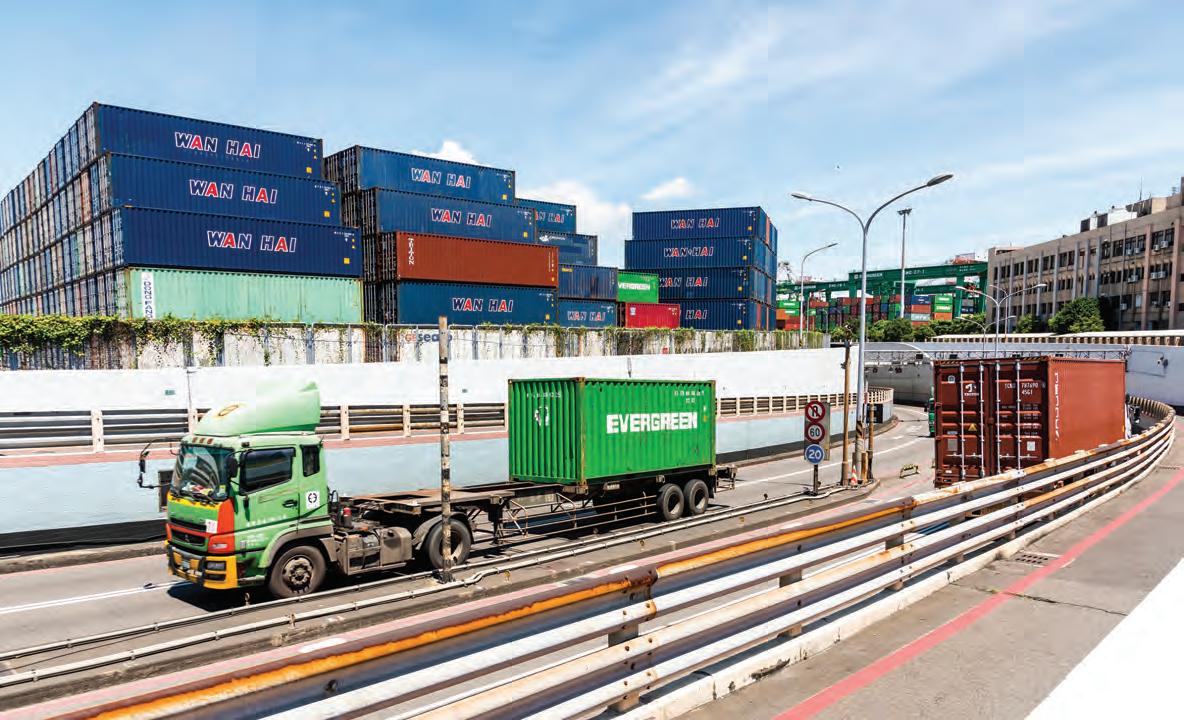
13 minute read
MARKET REPORT
from Global Trailer 63
by Prime Group
CHIPPING AT THE SEMICONDU MONOPOLY
THE GLOBAL DIGITAL ECONOMY IS ON TRACK TO SMASH A TRILLION US DOLLARS BY 2035 AND TAIWAN IS INCREASINGLY BECOMING A CRITICAL ENABLER OF THIS.
It takes an integrated semiconductor supply chain involving thousands of companies and millions of people to form the backbone of today’s digital economy. Such complexity drives 5G, Artificial Intelligence, Internet of Things (IoT), automotive, smart factories, quantum computing and data processing. All was going well, too, until Covid-19 came to town.
A shortage of integrated circuits has disrupted the productivity of automakers and commercial vehicle manufacturers worldwide. This key component, which is used across a range of sectors from transportation to communications to IT, is essential for managing the control and flow of modern electronic devices and equipment. These tiny transistors made from silicon are what enable our smartphones and computers to function. Following advances with in-cab
It reportedly takes eight hours to drive around the entire island of Taiwan. technology and telematics talking to trailers and feeding information back and forth to fleet controllers, semiconductors continue to surge in demand.
The impact of Covid-19 in terms of government enforced restrictions and protective measures carried out by private industry has slowed the rollout of semiconductors and the supply chain itself has caused further delays with delivery meaning that the average build times for various commercial vehicles has inflated by weeks, even months.
The situation will improve in due course but this hiccup in the grander scheme is worth exploring. After all, Taiwan, according to a report from Boston Consulting, is accountable for 92 per cent of the world’s most advanced semiconductor manufacturing capacity.
An immediate concern, similar to China’s market domination of urea, the key ingredient of diesel exhaust fluid, is the risk of associated with the concentration of semiconductor production in specific geographic regions. Add geopolitical tension to the mix when it comes to import/export tariffs for the provision of essential tech componentry and before you know it a trade war may ensue.
CTOR
Most military complexes around the world rely on semiconductors, too, and there has already been rigorous debate about national security in this regard. The conversation generally turns to cybersecurity – specifically, hardware vulnerabilities. A cyberattack on a vehicle could lead to chip failure, denial of service and breach of sensitive information. Another risk in the semiconductor industry is IoT. Experts in this field agree that hackers can infect a computer system with malware and the connections are generally deeper and not as well managed in a IOT-powered environment. A solution to this involves establishing hardware root of trust as a robust security option.
Again, the conversation about geopolitical tensions steers the conversation into the protection of data. IT specialists say the prospect of China, for example, using cyber tactics against Taiwan is real. The nation’s Ministry of Affairs claims it has reported a 40-fold increase in cyberattacks in 2020 compared to 2018, presumably from the Chinese mainland. These semiconductors are no laughing matter.
It is estimated that up to 22.5 per cent of the global Gross Domestic Product (GDP) is made up by the global digital economy. In the next 15 years the digital economy is projected to crack a trillion dollars.
The semiconductor supply chain features companies around the world including the US, China, South Korea, Germany, and of course, Taiwan.
The Semiconductor Industry Association (SIA), based in Washington, US, announced in January that global semiconductor industry sales were $49.7 billion USD in the month of November 2021, an increase of 23.5 per cent over the November 2020 total of $40.2 billion USD and 1.5 per cent more than the October 2021 total of $49.0 billion USD. The cumulative annual total of semiconductors sold through November 2021 reached 1.05 trillion, which is the industry’s highest-ever annual total.
Monthly sales are compiled by the World Semiconductor Trade Statistics (WSTS) organisation and represent a three-month moving average. SIA represents 98 per cent of the US semiconductor industry by revenue and nearly two-thirds of non-US chip firms.
“Global semiconductor sales remained strong in November, increasing substantially on a year-to-year basis across all major regional markets and semiconductor product categories,” said John Neuffer, SIA president and CEO. “With one month of 2021 sales data still to be reported, the industry has already set a new annual record for total semiconductor sales and units shipped, as chipmakers have substantially ramped up production to address high demand.”
Regionally, year-to-year sales increased in the Americas (28.7 per cent), Europe (26.3 per cent), Asia Pacific/All Other (22.2 per cent), China (21.4 per cent), and Japan (19.5 per cent). Month-to-month sales increased in the Americas

(4.2 per cent), Europe (3.1 per cent), Japan (1.1 per cent), and Asia Pacific/All Other (0.9 per cent), but fell slightly in China (-0.2 per cent).
Meanwhile, Taiwan Semiconductor Manufacturing Company (TSMC), which is reported to account for at least half of the global market, released its financial results for Q4 2021. This juggernaut reported consolidated revenue of $438.19 billion NT (approx. €13.9 billion) and net income of $166.23 billion NT (approx. €5.28 billion)
Year-over-year, fourth quarter revenue increased 21.2 per cent while net income and diluted EPS both increased 16.4 per cent. Compared to third quarter 2021, fourth quarter results represented a 5.7 per cent increase in revenue and a 6.4 per cent increase in net income.
In US dollars, fourth quarter revenue was $15.74 billion, which increased 24.1 per cent year-over-year and increased 5.8 per cent from the previous quarter.
Gross margin for the quarter was 52.7 per cent, operating margin was 41.7 per cent, and net profit margin was 37.9 per cent.
In the fourth quarter, shipments of ‘5-nanometer’ accounted for 23 per cent of total wafer revenue; ‘7-nanometer’ accounted for 27 per cent. Advanced technologies, defined as ‘7-nanometer’ and more advanced technologies, accounted for 50 per cent of total wafer revenue.
“Our fourth quarter business was supported by strong demand for our industry-leading 5-nanometer technology,” said Wendell Huang, VP and Chief Financial Officer of TSMC. “Moving into first quarter 2022, we expect our business to be supported by HPC-related demand, continued recovery in the automotive segment, and a milder smartphone seasonality than in recent years.”
Based on the company’s current business outlook, management expects the overall performance for first quarter 2022 to be as follows: Revenue is expected to be between $16.6 billion USD and $17.2 billion USD. Also, gross profit margin is expected to be between 53 per cent and 55 per cent; operating profit margin is expected to be between 42 per cent and 44 per cent. TSMC management further expects the 2022 capital budget to be between $40 billion USD and $44 billion USD.
The technologies enabled by semiconductors have allowed the world to work remotely, study, treat illness, order goods online and stay connected. It’s safe to say that without access to advanced supercomputers the development of Covid-19 vaccines would not have been possible. Despite achieving great successes in 2021, SIA, commented on the state of the industry and said there are also significant challenges ahead, namely the shortage:
“Unanticipated rising demand for semiconductors needed during the pandemic response, coupled with significant fluctuations in chip demand for other products such as cars, triggered a rippling supply-demand imbalance felt across the world. The semiconductor industry has worked diligently to increase production to address high demand, shipping more semiconductors on a monthly basis than ever before by the middle of 2021, but most industry analysts expect the shortage to linger into 2022.
“The shortage increased awareness of the importance of America’s semiconductor supply chains. Although geographic specialisation in the global chip supply chain has enabled tremendous growth and innovation in the industry, vulnerabilities in the supply chain have emerged in recent years. For example, in 2019, 100 per cent of the world’s most advanced logic semiconductors (< 10 nm) were produced overseas.
“The US government has taken notice of the need to fortify America’s semiconductor supply chains through robust investments
Taiwan boasts more than 90 per cent of the world’s most advanced semiconductor manufacturing.

FAST FACT
Semiconductors are changing the world from smartphones and computers to electric vehicles and industrial machines along with the many global businesses they enable.
The DHL Express team assists the Ministry of Foreign Affairs with Haiti earthquake relief.

in US chip production and innovation. In June 2021, the US Senate passed the United States Innovation and Competition Act (USICA), broad competitiveness legislation that includes $52 billion to bolster domestic chip manufacturing, research, and design. The semiconductor industry has urged the US House of Representatives to follow suit and send legislation to the President’s desk to be signed into law.
“In 2021, semiconductors helped steady a world wobbled by Covid-19, and the industry’s future has never been brighter. As semiconductor innovation and global chip
FAST FACT
In 2019, the automotive industry made up 9.8 per cent of all semiconductor applications. demand continue their inextricable rise, government and industry must work together to maintain America’s leadership in this foundational, indispensable technology.”
DHL Express Taiwan is the first international express service provider in Taiwan. It began operations in 1973 and continues to be the industry leader in Taiwan. The business adheres to the Deutsche Post DHL Group’s purpose of ‘Connecting People, Improving Lives’. With DHL Express’ four core values of Speed, Can Do, Right First Time and Passion, the firm is committed to facilitating international trade, strengthening connections between people, and ultimately improving people’s lives through fast and quality delivery services.
As the industry leader and responsible logistics service provider, it has been accelerating its sustainability roadmap and focusing on ESG (Environmental, Social, and Governance). The company’s goal is to reduce logistics-related emissions to zero by 2050 for climate protection. In particular, we are targeting alternative aviation fuels, the expansion of the zero-emission e-vehicle fleet and climate-neutral buildings.
“In Taiwan, we actively work towards becoming the market leader in green logistics by expanding our portfolio of green products and services and working with our customers to achieve their own climate protection targets,” DHL told Global Trailer.
For the last 49 years, DHL Express Taiwan continues to be the industry leader in Taiwan with a 45 per cent market share.
In 2009, DHL Express launched Taipei Gateway in Taoyuan International
DHL is a prominent logistics operator in Taiwan.
Airport and has since upgraded the facility to increase the handling capacity from 3,600 pieces to 11,000 pieces per hour.
To keep up with the growing service demand in Taoyuan, DHL Express Taiwan opened the largest service centre in the city in 2019. The 4,000-squaremetre facility brings significant improvements in shipment processing efficiency, storage space, and productivity.
“We have the largest retail network in Taiwan with partnerships with major convenience store chains and post offices,” said DHL.
“There are over 11,000 retail outlets and service points across Taiwan for more convenient delivery and pick-up options. Together with nine service centres around the country and 135 weekly flights, we offer fast transit time (same-day or next-day delivery at major Asian cities).”
On green logistics, DHL Taiwan aims to reduce all logistics-related emissions to net zero by the year 2050, in line with Deutsche Post DHL Group’s environmental goal of net zero emissions.
“We also offer green products from carbon reports, climate neutral shipping and green optimisation that help customers meet their climate change goals,” said DHL.
“The pandemic has shown that our Group’s Strategy 2025 focuses on our core offering and leveraging digitalisation to advance our operations put us in the right direction. In 2021, the DHL Express Commerce platform was awarded bronze for Best Innovative User Experiences awards at the 2021 Future Commerce awards held by Business Next Magazine in Taiwan. We were the only logistics company that received this award. The platform allows merchants to integrate e-commerce platforms in minutes with no development required, rate shipping cost at checkout in real-time, create shipment documentation in one click and reach international customers quickly and easily.
“On our commitment to being the Employer of Choice, DHL Express was recognised as the No. 1 Great Place to Work in 2021. DHL Express Taiwan also ranked as No.1 Best Workplaces in Taiwan™ 2021. Our quality customer service has also been consecutively awarded for the “Best Service in Taiwan” gold prize in the last three years.”
At the time of writing, DHL Express Taiwan has 335 vehicles serving the country with around 10 per cent of green vehicles.
Taiwan ranked 19th out of 169 countries in DHL’s Global Connectedness Index (GCI) 2020 and third in the Asia Pacific region. The GCI report development of trade, capital, information, and people flows at the global, regional, and national levels.
As one of the world’s largest exporters of merchandise, Taiwan is a major player in the world’s information and communication technology industry as well as a major supplier of goods across the industrial spectrum.
As Yung C. Ooi, Managing Director, DHL Express Taiwan, said in commenting on the GCI Report, “Being primarily an export market, Taiwanese companies have always been able to adapt quite quickly to changing environments. The stable economic and regulatory environment, as well as the geographic advantage of being in the core of East Asia network, have also provided Taiwan with economic development advantages. The Covid-19 pandemic has also proven that Taiwan manages public

FAST FACT
Did you know a semiconductor device contains many smaller circuits comprised of millions of transistors which are crammed onto a few millimetres of silicon? These devices are essential for modern electronics and is among the most traded products in the world behind crude oil , motor vehicle parts and refined oil.
health crises exceptionally well, which in a way enhances the competitive advantage of Taiwanese companies.”
According to the 2022 economic outlook report of Academia Sinica, Taiwan’s top research institution, the economic growth in Taiwan is 3.85 per cent. Due to supply chain bottlenecks and inflation risks, the global economic recovery is expected to lose momentum in 2022. However, as the vaccination rate increases in Taiwan, consumption is expected to pick up and help Taiwan achieve sustained economic growth.
The latest figures from the Ministry of Economic Affairs in Taiwan showed the production index of the nation’s manufacturing industry increased by 10.57 per cent in 2021, with the metals sector being the strongest performer, with its production value soaring 78.91 per cent in Q3 from the same period last year to reach NT$505.6 billion.
While the challenges from the pandemic continue, the industry is expected to grow this year as the export demands remain high.
According to Taiwan’s Industrial Technology Research Institute (ITRI), the overall output value of the nation’s manufacturing industry reached NT$23 trillion, with an annual growth rate of 21.26 per cent, which is the second-highest in history.
The ITRI forecasted that as both global and domestic demands are expected to surge in 2022, the manufacturing industry will continue to grow. The overall manufacturing output value is expected to reach NT$24.12 trillion, with an annual growth rate of 4.61 per cent.
As for the most popular freight tasks that DHL undertakes in Taiwan: “Our Express products provide international door-to-door express pick-up and delivery services of parcels and documents. We have global networks and specialists in more than 220 countries and territories to ensure fast delivery with end-to-end tracking.”
Taiwan is also host to unique challenges when it comes to supply chain.
As DHL’s 2020 GCI report stated, although more than 70 per cent of export shipments from Taiwan to RCEP countries are already tariff-free, Taiwan will miss out on trade opportunities with RCEP members and would lose 0.4 per cent in annual real income from reduced trade.
Taiwan’s petrochemical, upstream textile, and machine tool industries would encounter that Japanese and South Korean manufacturers might have lower tariffs under RCEP.
According to the Economic and Trade Negotiation Office of the Executive Yuan, the Taiwanese government is working on alternative options including joining the CPTPP, of which many of the member countries are Taiwan’s top trade partners. The office predicts that Taiwan will be able to expand its export market and drive GDP growth by at least 0.52 per cent if they successfully join the agreement.
www.globaltrailermag.com
In 1986, Yuan T. Lee won the Nobel Prize for chemistry.











